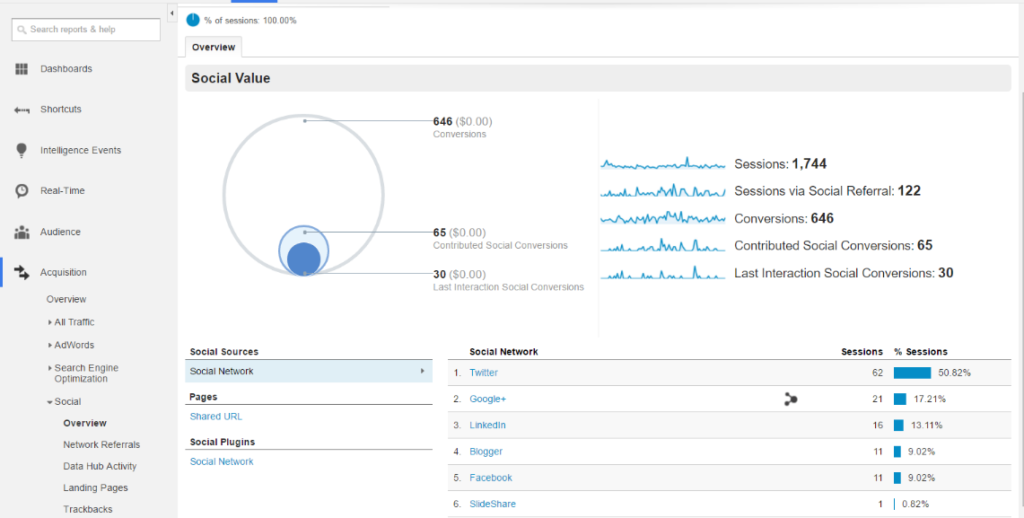Social media is an effective tool for achieving many of today’s marketing objectives. From brand awareness and engagement, to driving sales and leads, social media has proven itself to be a game-changer for organizations of all sizes, in every industry. Where social media often falls short? Proving return on investment (ROI).
Every marketer knows the plight of proving the value of your marketing efforts to management, the CEO, or Board. Executives want to know that every dollar is contributing to the bottom line, but quantifying the monetary value of a “like” or “retweet” isn’t crystal clear, or often convincing. This is especially true for nonprofit organizations, where every cent spent on marketing is a cent taken away from the serving its mission.
However, with the right systems in place, you can prove the ROI of social media by demonstrating how your social efforts lead customers to actions that drive sales, leads, or donations.
1. Use Google Analytics to capture social media referrals to your website and important pages
Every business and nonprofit should have Google Analytics installed on their website. Google Analytics is a free tool that tracks your website traffic and website visitor’s behavior on the site. If you haven’t already set up Google Analytics for your site, you can do so here.
The Google Analytics platform is highly comprehensive and features a “social media referrals” tool, tracking the number of users who were brought to your site directly through social media. Below is a screenshot of what this looks like in the Google Analytics platform:
With this feature, you can demonstrate social media ROI by showing that, because of social media content, users were interested in learning more about your organization and visited your site accordingly. You can also track user interest and behavior on specific pages. If you’re a nonprofit that cares about users visiting your “donate” page, Google Analytics can quantify how many users were taken to the donate page through Facebook, LinkedIn, Instagram, Twitter, and so forth.
2) Set up conversion tracking on Google Analytics, AdWords, and social media advertising platforms
On both Google and social media platforms, conversion tracking is when you identify an outcome you’d like a user to complete, such as purchasing a product. By installing a tag on your site, Google, Facebook, Twitter, and LinkedIn can quantify how many times users who click on your content convert to a “customer” – or completed your desired action.
For example, if your desired outcome is purchasing a product, you would set up conversion tracking so that the desired outcome is “user visits completed purchase page”. The process of setting this up can be convoluted if you’re inexperienced with website management. Fortunately, you can receive step-by-step instructions on setting up conversion tracking below:
3) Include a “how did you hear about us?” form in all communications
A simple, non-technical way to measure social media ROI? Ask users to declare how they found out about your organization. Whether the user is signing up for a newsletter, registering for an event, or is making a donation, adding in this simple question can help you better quantify how social media is bringing in revenue.
Make sure to ask customers which specific platform they discovered you on, rather than giving them the option to select “social media”, to help you further realize where you should be spending more time.
4) Give Instagram and Facebook fundraisers a try
By far the easiest way to prove social media ROI is to show a tangible revenue stream. Social media platforms are increasingly making it easier for nonprofits to bring in donations through their profiles. This year, Instagram launched a new feature that allows you to add a donation sticker to your Instagram stories. It works in conjunction with your Facebook business page, which also boasts a charitable feature called Facebook Fundraisers. You can even ask your fans and advocates to set up personal fundraising pages on their Facebook for your organization. The money donated through their Facebook portal automatically gets transferred to your linked bank account.
Leverage these tools in larger campaigns or when the mood strikes and track the total amount of money raised through social media over time to make a case no one can refute – it’s hard to argue with cold, hard cash!
5) Consider the benefits money can’t (always) buy
Social media’s benefits go beyond driving sales or donations. Consider other ways social media has helped or improve your organization to help make a case for your efforts. For example, a lot of users will go to an organization’s social media channels to find out more information or ask a question. Has customer service or satisfaction improved because of the responsiveness provided by social media?
Furthermore, while it may be difficult to put a price tag on metrics like awareness, that doesn’t mean it isn’t valuable to your organization. For example, nonprofits who want to leverage local officials and politicians to promote their cause or event will find that social media platforms like Twitter are an easy way to engage them. Often a retweet from a prominent figure is enough to cause a spike in web traffic, donations, or at the very least brand awareness.



